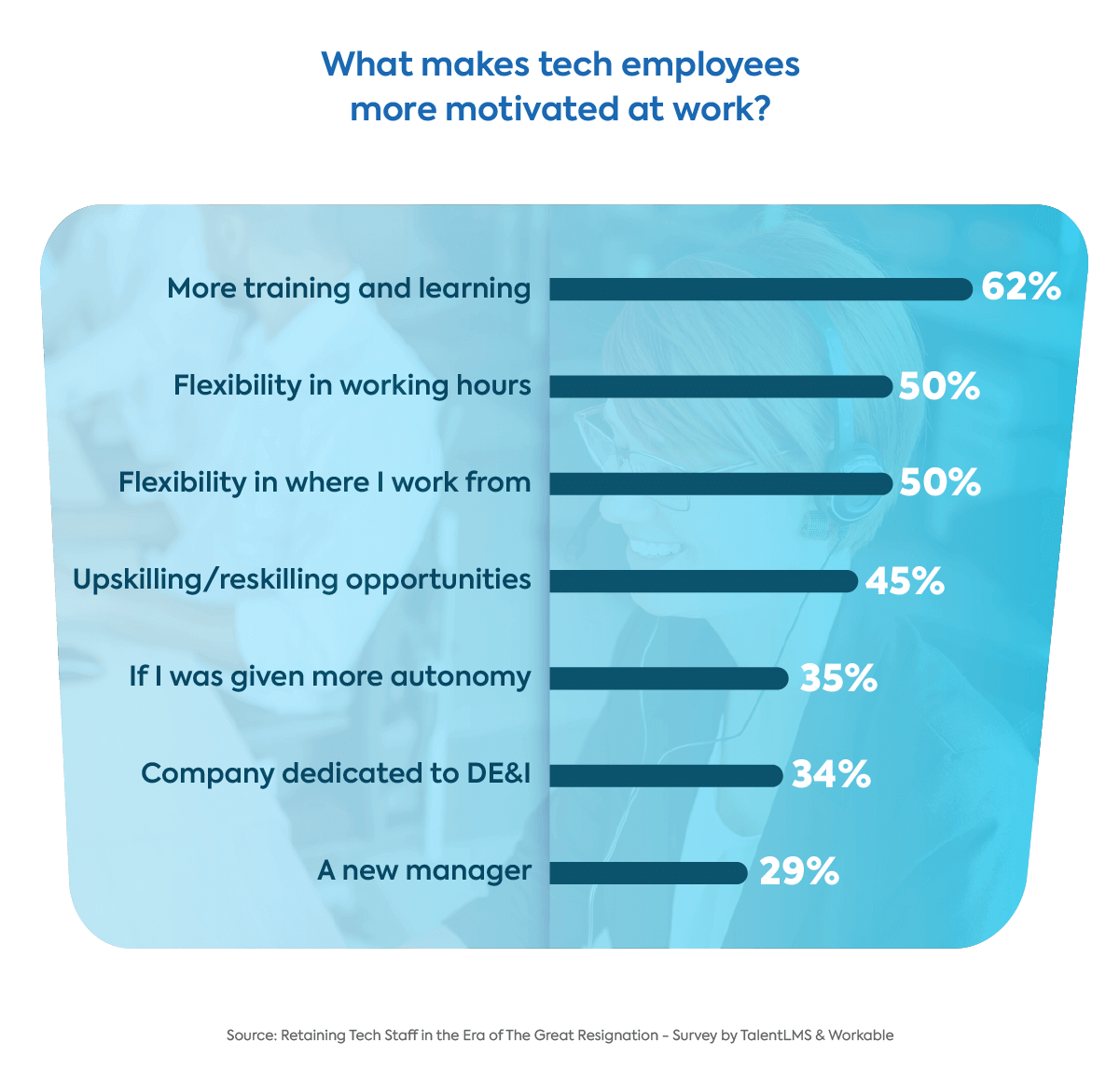Why you need the Pygmalion effect in your workplace
To explain what the Pygmalion effect is, why it’s important for the workplace, and how you can implement it in your organization, we’ll first tell you a little bit about Mindvalley.

Mindvalley is a learning experience company that has courses on personal growth, wellbeing, productivity, and spirituality. Their CEO, Vishen Lakhiani, used the Pygmalion effect in the workplace to build the company from scratch and now it has more than 200 employees in 40 countries around the world.
Not only that, but the company:
- Achieved a 45% year-over-year growth
- Quadrupled its revenue since 2016
- Has more than half a million students in their courses
- Was featured in the WorldBlu List of Most Democratic Workplaces for 11 years in a row
- Won three Malaysia’s Healthiest Workplace awards in 2019, for the healthiest employees, healthiest employer, and healthiest work environment
- Has a 4.1 satisfaction rating on Glassdoor, on par with Microsoft, Siemens, and O2
Also, they achieved all this with a predominantly millennial workforce; the average age of Mindvalley’s employees is 26.
The Pygmalion effect worked wonders for Mindvalley, so let’s look at what it is exactly, and how you can use it in your workplace.
What is the Pygmalion effect?
The Pygmalion effect describes the positive effect other people’s expectations have on a person’s performance. Otherwise said, what we think, act, perceive, and achieve can be positively influenced by other people’s expectations of us.
It was named after the Greek sculptor Pygmalion who carved a statue and wished (expected) for it to come alive… and it did!
Today, the effect is also known as the Rosenthal effect, after psychologist Robert Rosenthal, who studied the Pygmalion effect extensively.
Rosenthal conducted research in the classroom where he gave children an IQ test. After that, he shared the list of top performing kids with the teacher, and observed the teacher’s resulting behavior
The kids who were deemed fast learners progressed way better than the other kids because the teacher had higher expectations for them. The catch? Those ‘fast learners’ were actually selected at random and not at all due to their IQ test results.
The only difference in their learning was the teacher’s expectations from them. And still, they performed better than their peers and got better results regardless of their actual IQ test scores.
But the Pygmalion effect isn’t only limited to the classroom — it can be used in different work settings, from factories and banks to different service industries and even in the military. Companies such as Southwest Airlines, Ritz-Carlton, and Zappos all use it on a daily basis.
Four ways to use the Pygmalion effect in the workplace
Researchers have defined the four factors that will help organizations implement the Pygmalion effect in the workplace:
- Establish a leader-member exchange relationship
- Set goals
- Enable learning opportunities
- Provide timely and detailed feedback
Let’s look into each one.
1. Establish a leader-member exchange relationship
A strong manager-employee working relationship is all about creating a warm, nurturing, and safe environment where the newly hired worker can feel at ease, and easily focus on the task at hand.
The foundation of this relationship is trust, respect, and mutual obligation.
For this to work out, the leader needs to set up high expectations in a safe environment, whereas employees will feel motivated to fulfill those expectations.
They both create a relationship of trust, where they believe in each other and where there are no hidden agendas. The manager wants the employee to grow and be productive, while the employee doesn’t want to let down the manager.
How to implement this factor in the hiring process:
- Use a collaborative hiring process to immediately introduce the candidate to their future coworkers. The candidate will integrate easily with the new team, as they should have already met fellow team members during the hiring process.
2. Set clear and attainable goals
The leader needs to help the team member set high expectations for their goals. For this, the goals need to be:
- Specific. The employee needs to know exactly when a goal is reached.
- Difficult. The leader will set goals that are out of the worker’s comfort zone so they will have to apply themselves in order to succeed.
- Ambitious but realistic. The team member needs to know that if they apply themselves, they’ll hit the goal. If the goal is far above their current skill set, they’ll communicate that before they even start.
How to implement this factor in the hiring process:
- In the later stages of your hiring process, you can present challenges and case studies that are relevant to the candidate’s role and field.
- You can even include performance metrics (i.e. KPIs, OKRs) for the outlined goals in your job description. This will communicate to the candidates what’s expected from them to succeed in that specific role.
3. Enable learning opportunities
In the mid-1960s, Dr. James W. Sweeney was a teacher at the Tulane Biomedical Computer Center in New Orleans. He believed he could teach anyone to become a capable computer operator. And he did just that with George Johnson, a former hospital porter turned janitor, who was deemed a slow learner and was a poorly educated man.
Sweeney managed to teach Johnson so well that he became one of the top computer experts at the university. This event later became known as Sweeney’s Miracle.
Learning opportunities are essential in today’s marketplace. According to Gallup, 59% of millennials stated that learning and growth opportunities are crucial to them when picking out a job. Likewise for tech workers – another survey finds that 62% of tech workers cited “More training and learning” as a top motivator at work.
And finally, learning opportunities are more about the leader than the member. Creating the right learning environment means that the leader is not only confident in the employee’s ability to learn, but that they’re confident in their own ability to teach.
How to implement this factor in the hiring process:
- Include learning opportunities in your hiring process as a value proposition and attractor. You can even invite your candidates to take part in different learning opportunities such as MOOCs (Massive Open Online Courses).
- You can include details of your learning opportunities in your job description. That way, you will communicate to Millennials that they can grow personally and professionally in your company.
4. Provide timely and detailed feedback
Feedback helps the employee realize how far the goal is from where they’re currently at.
Leaders in organizations will usually offer more feedback to the candidates and employees they expect more of. They will also provide feedback more often with the focus on helping team members grow and improve.
Feedback will help employees grow personally and professionally. This means that they’ll reciprocate the attention by trusting their leaders and engaging in the task.
How to implement this factor in the hiring process:
- Have your managers with the best teaching skills mentor and onboard new employees in the company.
- According to research, the expectations set to the new employees in the first year will determine how much they contribute to the organizations within the next five years. So put your best people on it.
- Assign a mentor and a buddy to the new hire in your organization. A buddy will help with social integration, while a mentor will teach them the tools of the trade.
- Provide feedback to the candidates that didn’t make the cut. That will motivate them to apply again when they acquire new skills.
And now, the Golem effect
Leaders communicate the most when they try to communicate the least. Just think about it — silence, at a moment when you should be speaking, says more than anything you could say with words.
So if you have a leader who has low expectations for his or her team members or candidates, the opposite of the Pygmalion effect will happen — The Golem Effect. The low expectations from the manager causes the employees to fulfill those expectations, causing bad performance.
That’s exactly what happened at the Metropolitan Rockaway district office where they grouped agents with poor productivity into a single team. The agents’ productivity plummeted even further because even their manager knew that this group of agents was “the unsuccessful one.” Even nonverbal signs of communication set those expectations to the agents (such as being put in the group in the first place).
Otherwise said, employees (or applicants) will fulfill the expectations and their results will match the expectations from their leader, manager, or recruiter.
Believe in your people
In the end, people do what they believe they’re expected to do.
So believe in your people and have high expectations for them. You can further boost their performance by:
- Creating a safe environment where they can grow
- Pushing them to set goals that are audacious, but yet realistic
- Providing them with as many learning opportunities as possible
- Helping them grow by giving encouraging feedback (and doing it often)
Because if you follow these tips, you may find the same kind of employee engagement and retention numbers as that of Mindvalley. And not only can you use the Pygmalion effect in the workplace to retain top talent— you can use it to attract top talent.
Millennials want to work in an environment where they’re expected to be better, grow, and succeed. And with just a little bit of effort, your organization can be that place. You can break the ice by giving your employees flexible work hours – a way of showing trust and confidence in them.
And keep going from there. Rosenthal would agree and support that strategy.




